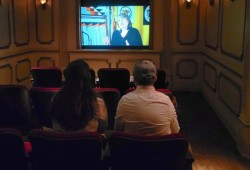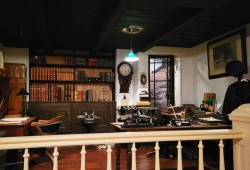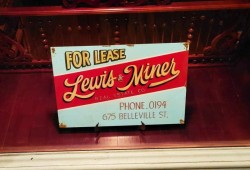In late 2021 the Royal B.C. Museum announced that they were shutting down their third floor to decant iconic exhibits, such as Old Town, to decolonize the museum. But less than two years later, Old Town reopened on July 29, with some changes and a new approach.
Old Town, originally created in the early 1970s, replicates a Victoria streetscape from the late nineteenth century to the early 20th century with cobble streets that visitors can walk while looking through window shops, the grand hotel, the train station, among other iconic features.
The last major update to the Old Town exhibit was the addition of Chinatown in the 1990s, done in collaboration with the Victoria’s Chinese Canadian community, reads a RBCM press release.
Though many of Old Town’s beloved features remain with its reopening, some new displays and contextual panels have been added and are forthcoming. The RBCM is referring to these changes as a reckoning.
“This street of wood cobblestones represents one layer and reconstruction of British Columbia’s past,” reads one of the panels. “Countless layers of lived experiences have gone unnoticed.”
“Each of these spaces represent different parts of British Columbia,” said Chris O’Connor, RBCM’s acting director of community engagement and regional partnerships, referencing the elements that make up Old Town. “But it’s all told through a perspective of museum staff, and often a particular kind of person, especially at that time.”
O’Connor said that though Old Town has been a very important and nostalgic space for many people, the exhibit doesn’t tell many stories.
“[Old Town] is supposed to reflect the diversity of lived experiences over time in British Columbia and needs to be told by the people that lived those experiences, or ancestors with those experiences,” said O’Connor. “That's the only real responsible way of doing museum work these days.”
Among some of the changes is the Sleeping Car Porters installed at the Old Town train station, a feature that came from an exhibition co-created with the B.C. Black History Awareness Society called “Hope Meets Action”.
At the entrance of Old Town, panels acknowledge Lekwungen people, also known as Esquimalt and Songhees, asking that visitors “keep this in mind” as they walk through Old Town.
O’Connor explained that in partnership with Songhees and Esquimalt Nations, this space will be reimagined on their terms.
Near the entrance, where Charlie Chaplin was previously playing in the Majestic Theatre, a series of films are shown that continue to be worked on, called Living Culture, Artist Profiles and Living Culture, Living Archives.
“I'm really happy to see an Indigenous film in there,” said Brianna Bear (Thealiye) of Songhees Nation, who grew up going to the RBCM. “That's the first thing that I gravitated towards.”
“I really like how they still have the Old Town, but it is that new approach where they're wanting to honor the land, the people that are from this land, and also the people who immigrated here too, in such a really beautiful way without losing the touch of what everyone knows is Old Town,” said Bear.
Among those included in the Living Culture films playing in the Majestic Theatre is Joe Martin of Tla-o-qui-aht.
Martin received the name Tutakwisnapšiƛ from his late-father, Robert Martin Senior (Nook-mis) at a potlatch.
“It comes with a role and responsibility,” said Martin. “Of teaching the laws of the land.”
“For me, I take this as a responsibility to be able to share as much as I can with anyone who will listen,” said Martin when asked about the Living Cultures, Living Archives films.
Steven Davies, the Indigenous Learning Program developer at RBCM, has been working for over two years with cultural ambassadors and leaders to produce the Living Culture films, which currently total 14.
“In my opinion, I think it's really important that Indigenous perspectives and voices are centered within all cultural institutions and centers,” said Davies.
Davies explained that the Living Culture films represent the diverse history of Indigenous people in B.C., and their continued cultural revitalization told from their own experiences.
He added that each artist retains the rights to the films, each with a copy of the interview material and film.
“I feel it's really important to counter some of the history of extraction that's been characterized throughout media production,” said Davies. “In a sense, [the films are] currently on loan to the museum.”
Tseshaht artist Joshua Watts was a Nuu-chah-nulth representative when the museum began its modernization process in 2019.
“I don't know exactly what the new approach entails,” said Watts. “I would hope that it would show an honest history because it’s romanticized and not really shared in a perspective that a lot of that lifestyle was on the backs of genocide, and a lot of that lifestyle was… from racism and was from the removal of our people.”
Watts said that though he enjoys the Old Town displays, he also feels that with the knowledge he has it’s difficult for him to fully appreciate them.
“I do feel like those displays are exploiting the fact that a lot of people are uneducated, or in fact, kind of ignorant to the true history and the violence that happened here,” said Watts.
Watts explained that for him and his community, violence from the residential school system is a part of Old Town, but this is absent from what the tourists see.
“Historically speaking, these were places of exclusion either formally or informally,” said O’Connor. “We also want to be mindful of that and reveal that as well.”
“Not pretend like everyone was welcomed in spaces like this,” he continued.
O’Connor explained that the shift in the new approach is to have the museum take on a role of facilitator for exhibits rather than the authority.
“It's very colonial posture to [have] museums as authority, telling the story of a place,” he said.
“What we're really wanting to do is centre community voices [and] bring in actual lived experiences so that people understand that history from people,” O’Connor added.
Other iconic exhibits from the Becoming BC gallery, such as the Captain George Vancouver's HMS Discovery ship, are to be “refreshed and reopened” in the coming year, reads the RBCM press release.
“The idea is that now Old Town is a community engagement space,” said Leslie Brown, the museum’s board chair, pointing to a for-lease sign in what was previously known as the drapers in Old Town. “We want to work with people to say, ‘What do you want to see here?’.”
Brown said that in every space there has been something “updated or cleaned out.”
“This is just our first cut at it,” she said.
The First Peoples Gallery, located next to the Old Town, remains closed as the RBCM continues to work closely with First Nation communities to reimagine the space, said Brown, adding that they are hoping to open sometime in 2024.
“I'm really happy with the fact that [RBCM is] taking their time and letting people know that, yes, we will be honoring the land, more so than what we are right now,” said Bear.
“It's our job to create space for… so many different folks to be able to tell their own story and facilitate that process in a way that makes sense for them,” said O’Connor. “And not on our terms.”




